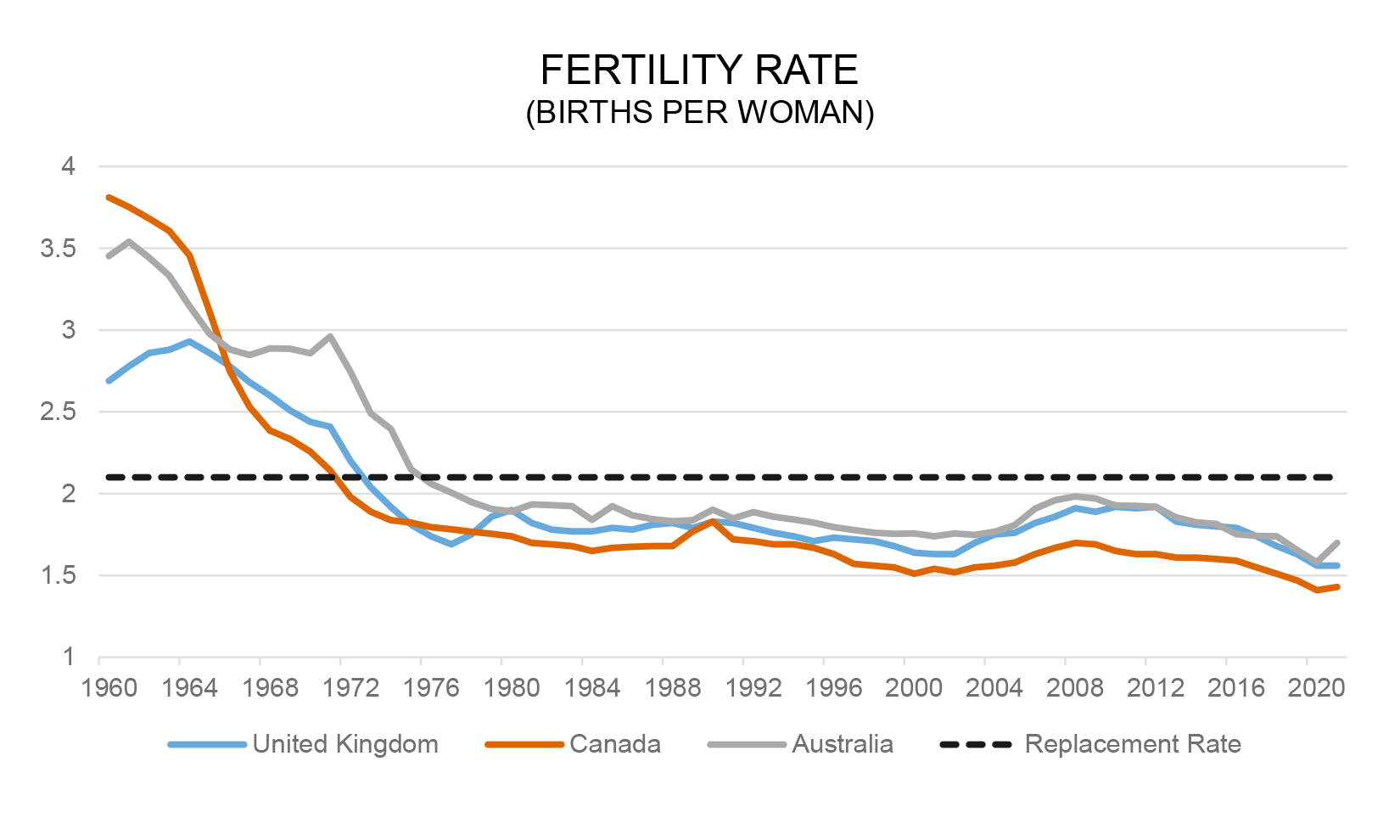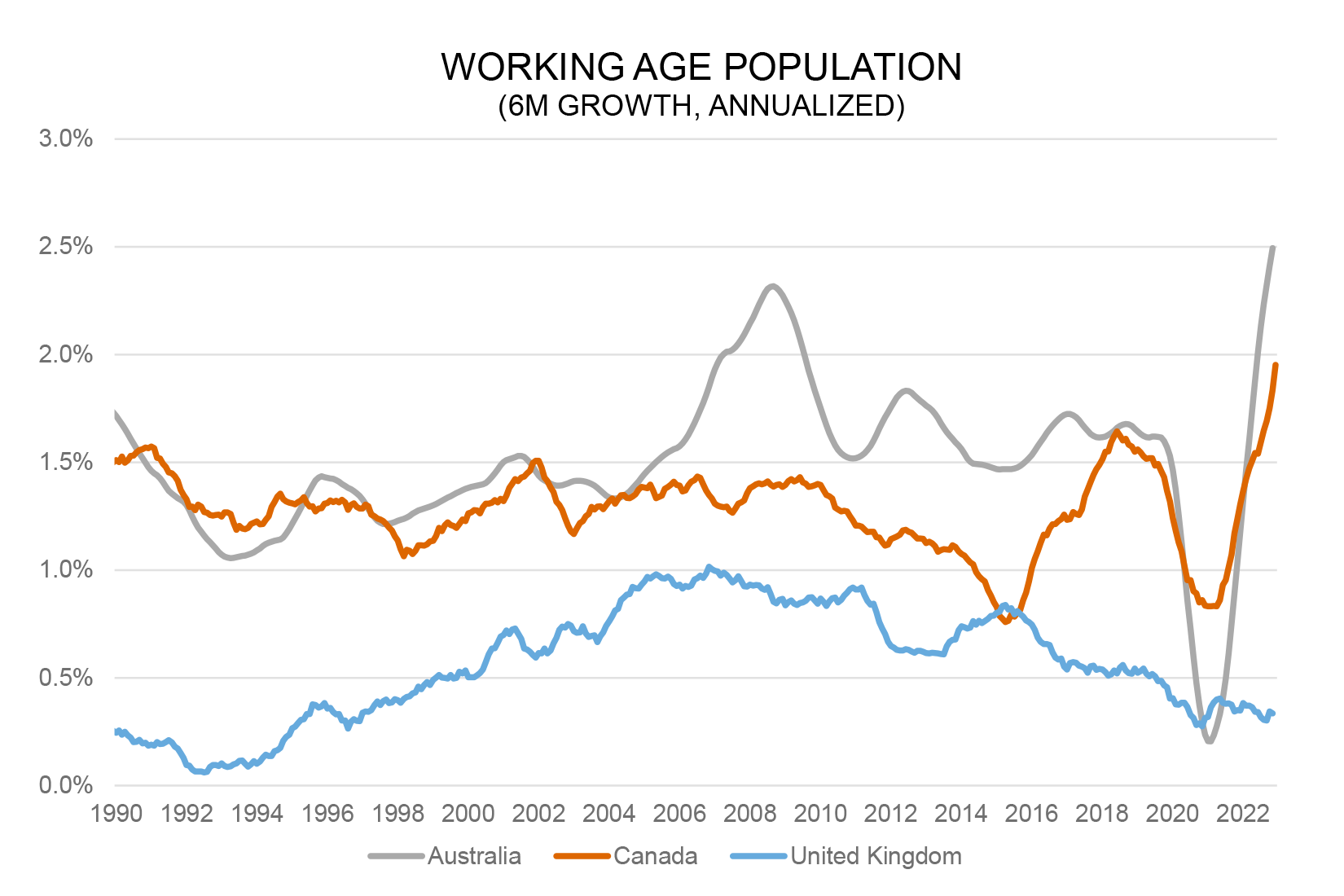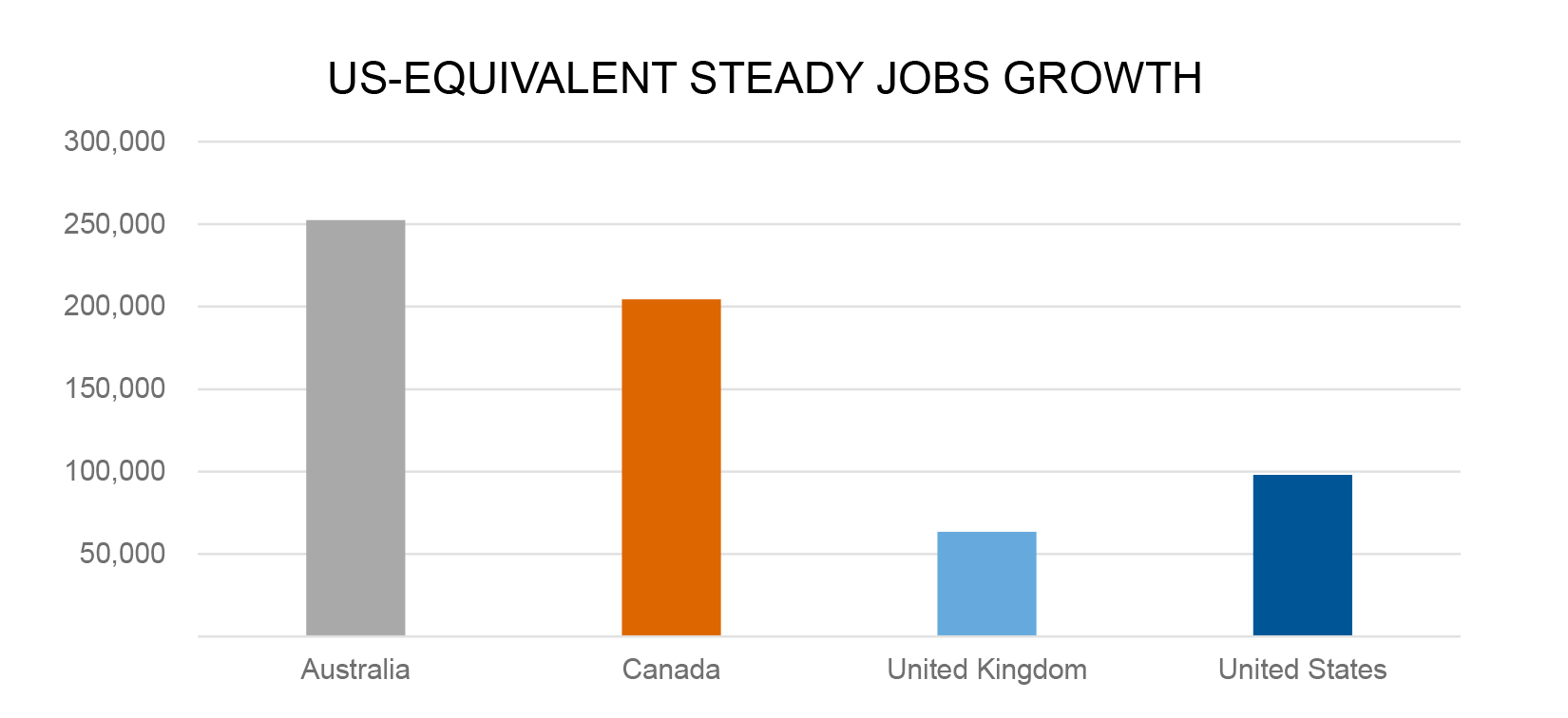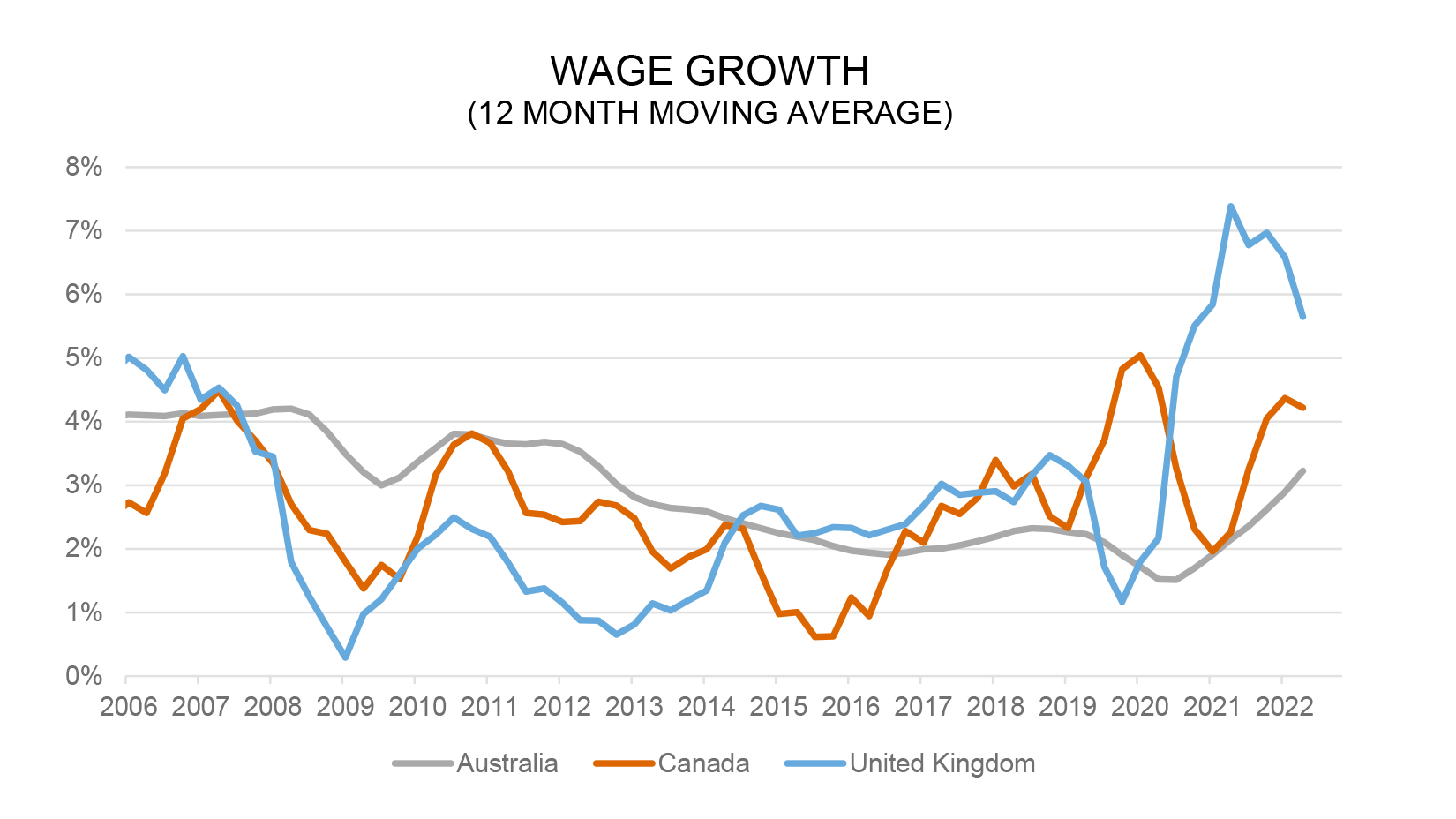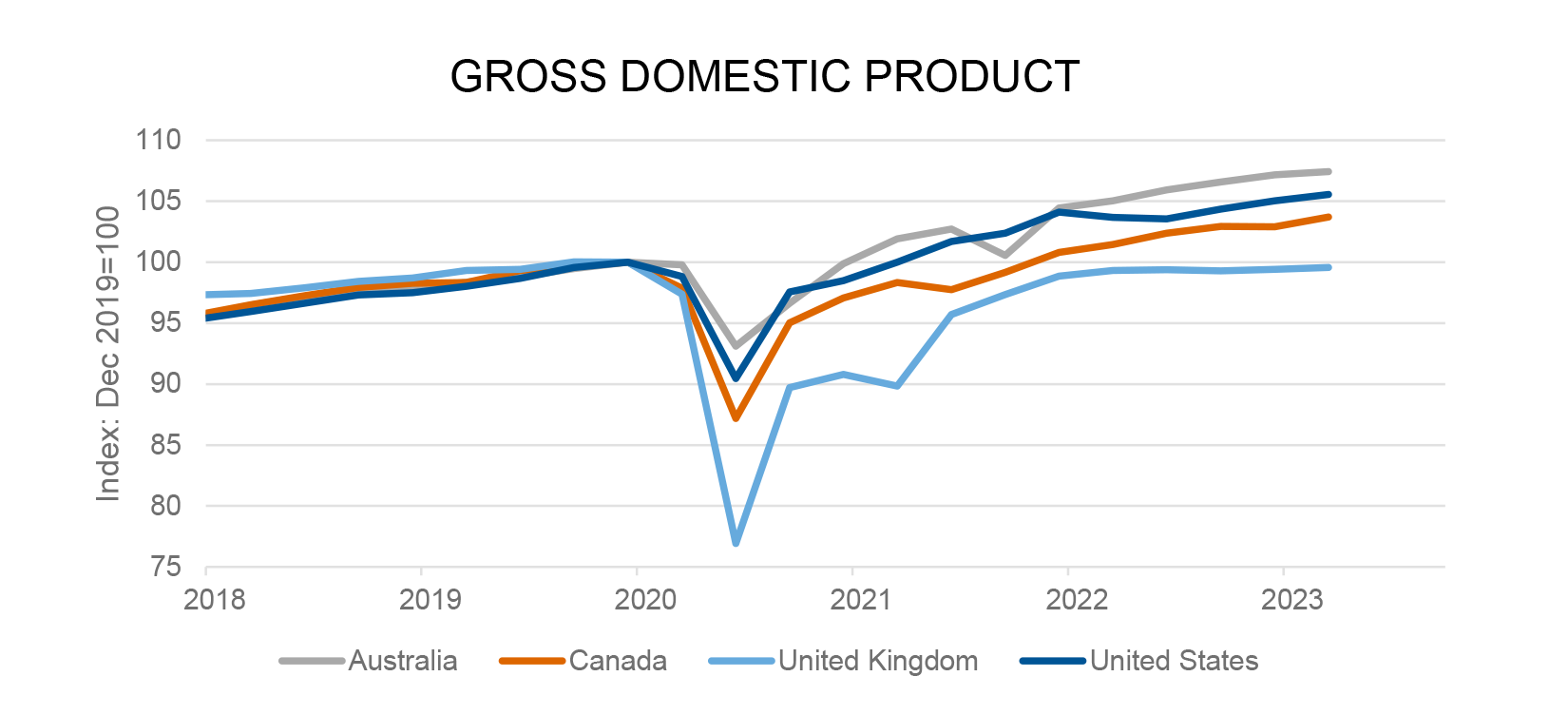The economics of immigration: The UK vs. Australia and Canada
Executive summary:
- Australia and Canada are experiencing a surge in population growth, while growth rates have slowed substantially in the UK due to post-Brexit frictions.
- The robust population growth is allowing Australia and Canada to generate stronger jobs gains without causing a tighter labour markets and strong wage growth.
- The sluggish population growth in the UK is helping make for a tight labour market and persistently high levels of inflation.
The concept of potential growth is a very powerful one in economics, and feeds into a lot of asset class return calculations. For example, it can inform the neutral rate of interest, which feeds into longer term interest rates. Additionally, potential growth can be an anchor for longer-term growth assumptions, which are fed into discounted cash flow models used in equity markets.
Potential growth is made up of two factors: population growth and productivity growth. Basically, an economy’s long-term prospects are determined by the growth in potential workers and how much each worker can produce. Productivity growth is notoriously hard to forecast, with demographics being a bit more straightforward using average life expectancies, fertility rates and immigration.
We can see the impact of demographics, and particularly immigration, very clearly right now by comparing the United Kingdom, Canada and Australia. The UK is struggling with a serious labour shortage and inflation problem, while Australia and Canada have been able to adopt slightly less aggressive monetary policy as immigration has provided relief to the labour market.
Fertility rates in the developed world have been low for a long time
Before jumping into the differences in migration, we should take a step back and look at the broader demographic trends across the three countries. The fertility rate, or births per woman, is a very important indicator for long-term population growth. For a population to stay at a constant level, a country needs to have roughly 2.1 births per woman (called the replacement rate). It is slightly higher than 2 because of infant mortality (which has declined over time) and some families having less than 2 children (which has grown over time). As the chart below shows, most of these countries have seen fertility rates below 2.1 for some time now. Hence, for the population to keep growing (which has a follow-on effect on the economy growing), these countries must rely on migration.
(Click image to enlarge)
Source: Refinitiv Datastream, World Bank, 12 May 2023
Canada and Australia have seen rapid population growth
Now let’s look at recent population growth estimates for each of the countries. Whilst population censuses are only taken every couple of years, labour statistics agencies provide estimates of population each month as part of their labour force report. The chart below shows the six-month change (annualised) in population aged 15 years and older.1 As you can see, Australia and Canada are experiencing a surge in population as net migration recovers after falling during COVID. In comparison, the United Kingdom has seen a continued slowing in population growth as post-Brexit frictions make the UK a less desirable destination for immigrants.
(Click image to enlarge)
Source: Macrobond, 11 July 2023
This population growth has two big implications for economies. The first is it provides a boost to demand – and provides a buffer against recession. One of the reasons that Australia had been able to avoid recession for so long was in part due to the strong population growth. The second, and related point, is that it allows an economy to delay hitting capacity constraints as quickly. An economy that has a faster population can, all else equal, achieve stronger jobs growth without creating tightness in the labour market.
Net migration can alleviate labour shortages
The U.S. Federal Reserve Bank of Atlanta (Atlanta Fed) has a measure that looks at the average monthly jobs growth that can be achieved without seeing a decline in the unemployment rate. Currently, this estimate sits at 99,000 jobs per month. We can do some similar calculations for the other countries using some similar assumptions. We assume that participation rates remain unchanged – that is, the proportion of people of working age (15 years and older) who are working or looking for work holds steady. Over the longer term, this is unlikely to be appropriate as older cohorts enter retirement but over a shorter horizon, it is fine. We also take population growth from the respective governments and assume that the working age growth is equal to the overall population growth (given that immigration tends to be skewed toward working age individuals).
The table below compares the sustainable job growth numbers across the countries, scaled to the size of the United States for ease of comparison.2 The strong population growth means that Canada and Australia are able to generate stronger jobs gains without causing a tighter labour markets and wage growth.
(Click image to enlarge)
Source: Refinitiv Datastream, 10 July 2023
Indeed, we have seen the wage growth in Australia and Canada be notably lower than the U.S. or UK over the last 18 months – a period during which the flow of migration has returned for both countries.
(Click image to enlarge)
Source: Refinitiv Datastream, 10 July 2023
United Kingdom is in a difficult place
Of course, not everything can be seen with rose-tinted glasses in Australia and Canada. The former is seeing pretty significant increases in rent prices currently (in part, due to this strong population growth coupled with housing shortages), and both are going through a period of higher interest rates with very elevated levels of household debt. However, both countries are in a much more advantageous position than the United Kingdom. After all, not only is the UK economy suffering from a tight labour market and persistent inflation, but as we noted in our Global Market Outlook, it has yet to surpass pre-pandemic levels of economic activity.
(Click image to enlarge)
Source: Refinitiv Datastream, 10 July 2023
The bottom line
In the post-COVID era, a recovery in net migration in both Australia and Canada has boosted population growth, helping to stave off labour shortages in both regions. The situation differs considerably in the UK, where a much-slower pace of net migration has contributed to higher wage growth and a tighter labour market. Ultimately, these differences underscore the vital role that immigration can play in shaping a country’s economic growth trajectory.
1 For the United Kingdom, the chart is showing the growth of 16 years and older.
2 The actual figures for Canada, Australia and the United Kingdom are 24,800, 20,600 and 12,900 respectively.
Any opinion expressed is that of Russell Investments, is not a statement of fact, is subject to change and does not constitute investment advice.
